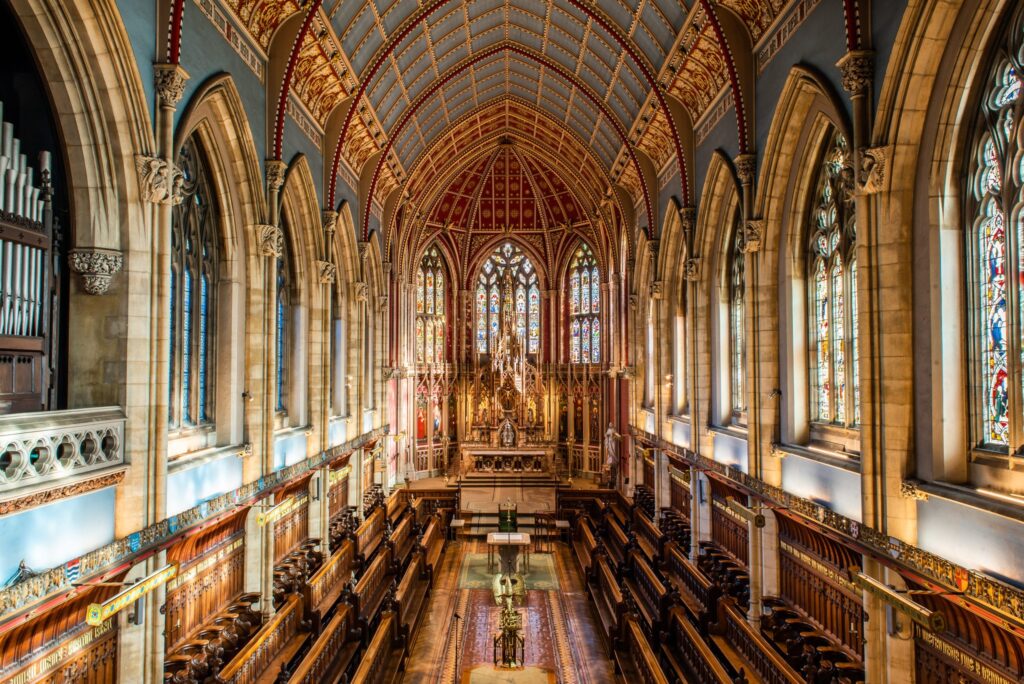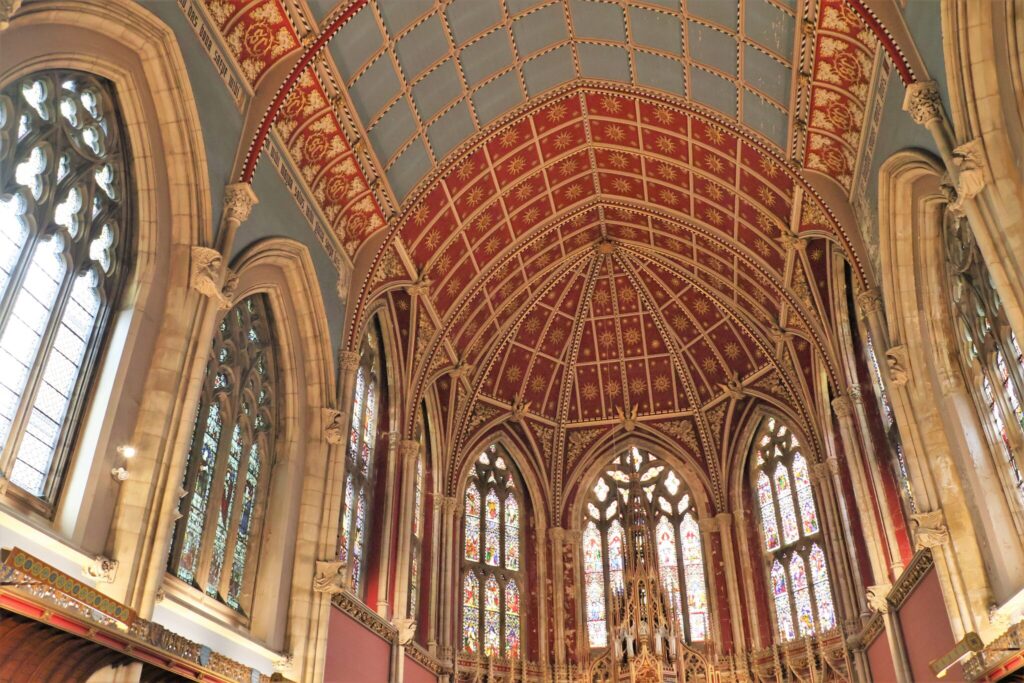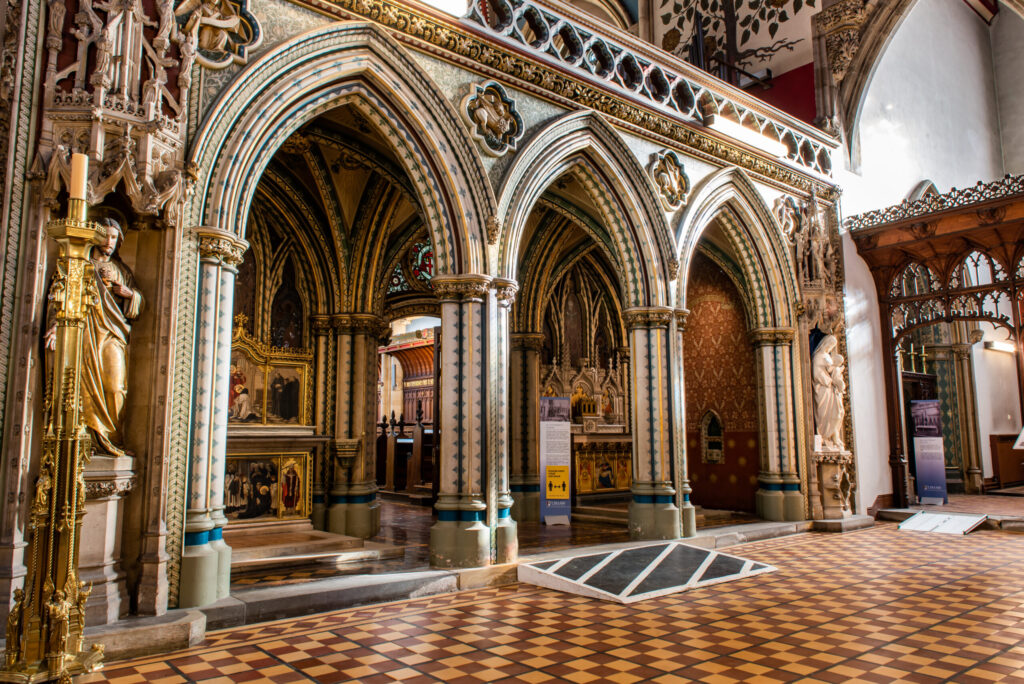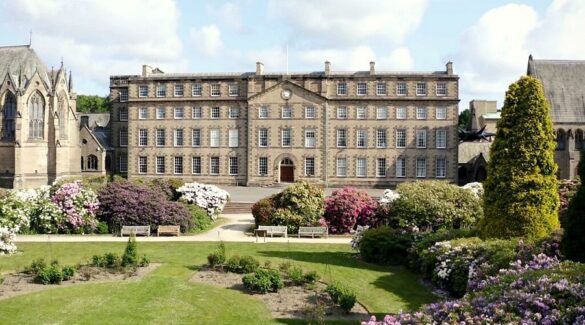Just a few miles outside the city of Durham lies one of the region’s most captivating hidden gems: Ushaw Historic House, Chapels & Gardens. Steeped in history, rich in architecture, and surrounded by beautiful landscaped grounds, Ushaw offers visitors an experience that is equal parts cultural, spiritual, and leisurely. For those with an interest in heritage, art, or simply a peaceful day out in nature, it is a destination not to be missed.
Ushaw is not just a house or a garden—it is a place where centuries of history, faith, and education converge. Once a Catholic seminary, it is now a thriving cultural venue and visitor attraction, showcasing magnificent chapels, historic interiors, exhibitions, and extensive gardens that invite exploration. Whether you’re drawn to the grandeur of its chapels, the intimacy of its historic rooms, or the tranquillity of its gardens, Ushaw leaves a lasting impression on all who visit.

A Brief History of Ushaw
The story of Ushaw begins in the early 19th century. Following the English Reformation, Catholics faced centuries of persecution, and seminaries were forced to operate abroad. One such seminary was based in Douai, France, but the upheaval of the French Revolution meant that English students training for the priesthood had to return home. In 1808, Ushaw became their new home, founded as St Cuthbert’s College, a seminary and place of Catholic education.
From its earliest years, Ushaw grew into a place of learning and devotion. The college trained priests for generations, but it was also a hub of culture, architecture, and community. The buildings expanded throughout the 19th century, with contributions from some of the most celebrated architects of the time, including Augustus Pugin, famed for his role in designing the interiors of the Houses of Parliament.
By the late 20th century, with fewer vocations to the priesthood, Ushaw’s role as a seminary declined, and in 2011 the college closed its doors to students. However, rather than falling into obscurity, Ushaw found a new life as a heritage site and visitor attraction. Today, it welcomes people of all backgrounds, inviting them to discover its treasures and enjoy its remarkable setting.
The Historic House
The heart of Ushaw is its Historic House, a striking collection of buildings that reflect centuries of craftsmanship and devotion. Walking through its corridors is like stepping back in time. The house contains an array of rooms, from formal dining areas and libraries to study spaces and communal halls, each telling its own part of the story.
One of the joys of visiting Ushaw is the sense of discovery. Around every corner, you find details that speak of its layered history—wooden carvings, portraits of past figures, intricate tiles, and the atmosphere of a place that has seen countless students pass through its doors. It feels both stately and lived-in, a house that has served as both home and institution.
The library, in particular, is a highlight. With shelves lined with volumes that span theology, history, literature, and science, it reflects Ushaw’s role not only as a religious seminary but as a place of scholarship. Many of these works are rare and valuable, making the library a treasure trove for anyone with a love of books and learning.
The Chapels
No visit to Ushaw is complete without exploring its chapels. These are the jewels of the estate, architectural masterpieces that combine grandeur with devotion. Ushaw is home to several chapels, each with its own character, but together they form a breathtaking collection of sacred spaces.
The most famous is St Cuthbert’s Chapel, the main chapel of the former seminary. Designed by Joseph Hansom and later enhanced by Pugin, it is a feast for the senses. The soaring arches, stained glass windows, ornate altars, and carved wooden stalls create a space that is both awe-inspiring and intimate. When sunlight filters through the coloured glass, bathing the interior in hues of red, blue, and gold, the effect is magical.

Other chapels, such as the Chapel of the Sacred Heart and the Lady Chapel, showcase the variety of styles and devotions that shaped Ushaw over the centuries. Each has its own atmosphere—some quiet and contemplative, others richly decorated with symbols and art. Collectively, they provide a glimpse into the spiritual heart of Ushaw and its role as a place of prayer and formation.

For many visitors, these chapels are the highlight of the visit. Even those with no religious background or belief often find themselves moved by the sheer beauty and craftsmanship on display. The chapels are not simply relics of the past; they are living works of art that continue to inspire reflection.

The Gardens and Grounds
Beyond the buildings, Ushaw’s gardens and grounds stretch out into acres of greenery. Landscaped to provide beauty and peace, they offer the perfect counterbalance to the grandeur of the interiors. Walking through them, you encounter formal gardens, woodlands, meadows, and open lawns that invite relaxation and exploration.
The gardens are designed to change with the seasons. In spring, flowers burst into bloom, filling the air with colour and fragrance. Summer brings lush greenery and long, light-filled days perfect for picnics or leisurely strolls. Autumn transforms the grounds into a palette of golds and reds, while winter offers stark beauty, with frosted lawns and evergreens providing quiet charm.
Sculptures and installations are dotted throughout the grounds, reflecting Ushaw’s current role as a cultural venue. These works of art add a modern touch to the historic setting, creating dialogues between past and present. Walking through the gardens, you never quite know what you will find next—a sculpture framed by trees, a secluded bench with a view, or a sweeping vista of the house itself.
The grounds are also home to wildlife. Birds, squirrels, and insects thrive in the varied habitats, and careful stewardship ensures that Ushaw is a place where nature is valued alongside heritage. For those seeking tranquillity, the gardens provide space to pause, breathe, and take in the beauty of the surroundings.
Cultural Events and Exhibitions
One of the things that makes Ushaw so vibrant today is its role as a cultural hub. The estate regularly hosts exhibitions, concerts, and events that attract visitors from near and far. These range from art exhibitions in the historic rooms to classical music performances in the chapels, where the acoustics bring every note to life.
Seasonal events, such as Christmas light trails or Easter celebrations, draw families and communities together. Workshops, talks, and guided tours add layers of engagement, helping visitors connect more deeply with Ushaw’s history and heritage.
In many ways, this continuation of cultural life is a natural extension of Ushaw’s past. As a seminary and place of learning, it always valued the arts, music, and intellectual exchange. Today, that legacy continues in a new form, opening its doors to all and ensuring that Ushaw remains not just a preserved monument but a living, breathing venue.
A Place for Reflection
Beyond its history and culture, Ushaw is also a place for personal reflection. Many visitors describe a sense of peace as they wander through the chapels or gardens. There is something about the combination of grandeur and serenity that encourages stillness. It is a reminder of the importance of places that allow us to pause in the midst of busy lives.
For some, this reflection may be spiritual; for others, it may simply be the chance to appreciate beauty, heritage, and nature. Ushaw accommodates both. It is not only a Catholic heritage site but a welcoming space for anyone with an interest in history, architecture, or gardens. Its appeal is universal, and its atmosphere inclusive.
Why Visit Ushaw?
So why should Ushaw be on your list of places to visit in County Durham? The answer lies in its unique combination of features. Few places offer such a blend of historic architecture, stunning chapels, expansive gardens, and cultural events all in one setting. It is a destination where you can spend hours exploring indoors and outdoors, immersed in heritage yet very much in the present moment.
Ushaw also represents a story of resilience and renewal. From its origins as a seminary in exile to its rebirth as a cultural venue, it embodies the ability of places to adapt, endure, and thrive. Visiting Ushaw is not only an encounter with history but also with a living tradition that continues to evolve.
Lasting Impressions
Leaving Ushaw, it is hard not to feel enriched. The beauty of the chapels, the grandeur of the historic house, the peace of the gardens—all combine to create an experience that lingers in memory. Whether you come for the history, the architecture, the art, or simply a day in beautiful surroundings, Ushaw offers something that speaks to the soul.
It is a place that rewards slow exploration. Rushing through would miss the details—the carvings in the wood, the flicker of light on stained glass, the quiet corners of the garden. It is a destination to savour, where every turn reveals something new.
For anyone visiting Durham, Ushaw Historic House, Chapels & Gardens is an essential stop. It is a reminder that some of the most remarkable treasures lie not in the heart of cities but just beyond, waiting to be discovered.

